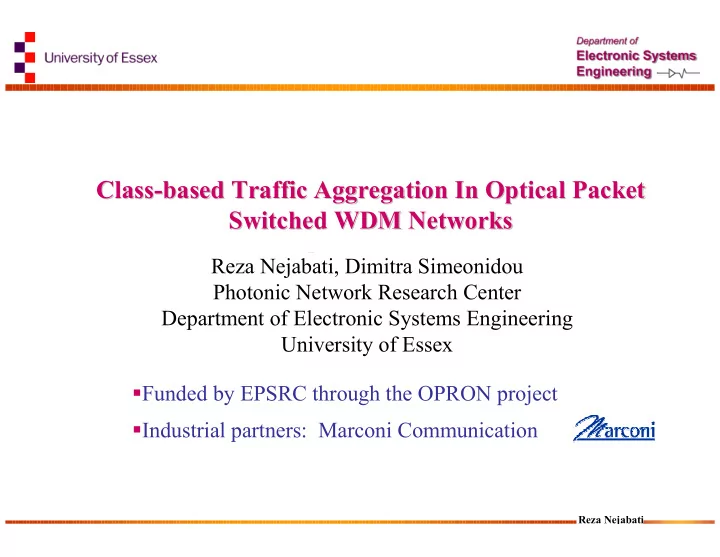

Class- -based Traffic Aggregation In Optical Packet based Traffic Aggregation In Optical Packet Class Switched WDM Networks Switched WDM Networks Reza Nejabati, Dimitra Simeonidou Photonic Network Research Center Department of Electronic Systems Engineering University of Essex � Funded by EPSRC through the OPRON project � Industrial partners: Marconi Communication Reza Nejabati
Topics Topics � Optical packet switching � Network scenario � Edge optical packet switch router � Optical packet assembly and packet aggregation � Traffic shaping in edge optical packet switch router � Realisation of the edge optical packet switch router Reza Nejabati
Why Optical Packet Switching? Why Optical Packet Switching? � Spectral efficiency � Multi-service traffic is bursty in nature � Future networks are IP-centric network � Circuit switched channels must have sufficient bandwidth to cope with peak transmission � In packet networks capacity is allocated at per packet demand � Improved network economics in packet networks (smaller OXCs) � Circuit switched networks provide granularity only at wavelength level, packet technology supports higher granularity � Convergence of electronic and optical technologies (IP/OPS) � Control and management integration and simplification (GMPLS) Reza Nejabati
Optical Packet Switching Scenario Optical Packet Switching Scenario � Opto-electronic in the edges, all-optical techniques in the core of the network � In the edges : aggregation, classification, packetisation, traffic shaping and QoS � In the all-optical core nodes: optimisation of network resources, label swapping, space switching, contention resolution with dedicated physical resources per QoS, regeneration � Optical bandwidth partitioning between circuit switching and packet switching � Circuit switching : some wavelengths dedicated � Packet switching : the rest of the optical band Reza Nejabati
OPS as Ingress Node and Egress Node for the OTN OPS as Ingress Node and Egress Node for the OTN SONET SONET SONET Customer PC Customer PC /SDH /SDH /SDH ISP ISP LSR LSR Edge Edge Optical Transport Network Optical Transport Network OPS OPS ISP ISP LSR LSR Core Core OPS OPS SONET SONET OXC OXC OXC LSR LSR ISP ISP /SDH /SDH Edge Edge OPS OPS Customer PC Customer PC LSR LSR ISP ISP OPS OPS OPS OPS OPS OPS Electronic (LSR) Electronic (LSR) Electronic (LSR) Electronic (LSR) Electronic (LSR) Electronic (LSR) Electronic (LSR) Electronic (LSR) Electronic (LSR) Client Client Client Client Client Client Electronic (LSR) Electronic (LSR) Electronic (LSR) Client Client Client Client Client Client � OPS provides an aggregation mechanism that maps higher layer packets such as IP and ATM from multiple sources into optical packets � The aggregation brings about traffic shaping, QoS classification, bit rate adaptation etc. for transmission at the core network � Aggregating nodes map these optical packets onto appropriate wavelengths for routing over the optical network Reza Nejabati
Functional Architecture for the OPS as Ingress Node Functional Architecture for the OPS as Ingress Node � Generic functions of the edge OPS router as an ingress node: � Header (label) extraction � Forwarding and classification � Aggregation and optical packet construction � Optical packet scheduling � Optical header insertion � Dynamic wavelength assignments Classification Wavelength Routing Assigning Packet Optical output links Electronic input links Processing Optical Packet Class based Tuneable Input Forward Construction Packet Optical Interface Engine Scheduling Aggregation Modulator Class-based Packet Aggregation Header Insertion Reza Nejabati
Packet Aggregation Packet Aggregation � Packet aggregation: � To reduce number of entities that must be processed in the core per unit time � To classify packets and to shape the traffic � Packets are aggregated based on two parameters: � Destination address and class of service � Aggregated packets are scheduled based on two parameters: � Number of bytes and maximum experienced delay � Aggregation method has directly impact on the traffic characteristics � Degree of self-similarity and correlation of traffic � Aggregation mechanism can be used for traffic shaping to : � Reduce effect of self-similarity, burstiness, traffic correlation � Make period of congestion more predictable � Make congestion feeble and decrease losses during periods of network congestion Reza Nejabati
Aggregation Method Aggregation Method � Traffic aggregation algorithm: � Based on increasing the probability of optical packet transmission with same size and same experienced delay. � Define an aggregation window (trigger zone): � Aggregation window on experienced delay (maximum aggregation time) � Aggregation window on number of bytes per optical packet � Simulation setup � Simulation has been used: � 20 clients each 1Gbps � To evaluate Effect of the aggregation � One output link with 40 Gbps algorithm on traffic characteristics � Three class of service � Three aggregation buffers � Two destination addresses Reza Nejabati
Simulation Results (Aggregation Delay) Simulation Results (Aggregation Delay) � Mean aggregation delay Reza Nejabati
Simulation Results (Self- -similarity) similarity) Simulation Results (Self Hurst parameter Traffic correlation Reza Nejabati
Hardware Implementation Implementation Hardware Fast tunable laser and high-speed reconfigureable hardware (fast FPGAs) with embedded processor provide a suitable hardware platform for implementing network processor functionality . 2.5Gbps Links Reza Nejabati
Hardware Implementation (Results) Hardware Implementation (Results) Laser Control Laser Control Wavelength Wavelength Tuneable Tuneable DAC DAC (GCSR) laser (GCSR) laser Lookup table Lookup table Aggregation Aggregation Control Control Hardware Hardware Logic Logic 10 Gbps 10 Gbps 2.5 Gbps 2.5 Gbps Transmission Transmission Modulator Modulator MUX MUX FIFO FIFO / 1 / 2 / 3 / 4 Reza Nejabati
Conclusion Conclusion � Optical packet switching is an attractive alternative for efficient realising IP over WDM networks � Traffic aggregation can be used : � To increase performance of the core � To provide quality of service � To shape traffic for the core � The proposed aggregation algorithm improves traffic characteristics : � Decreases the experienced delay by packets in the aggregation buffers � Reduces Hurst parameter and degree of self similarity � By using fast tunable laser and high-speed reconfigureable hardware it is possible to achieve required functionality for the fast tuneable optical packet generator in the edge OPS router Reza Nejabati
Thank you rnejab@essex.ac.uk Reza Nejabati
Recommend
More recommend